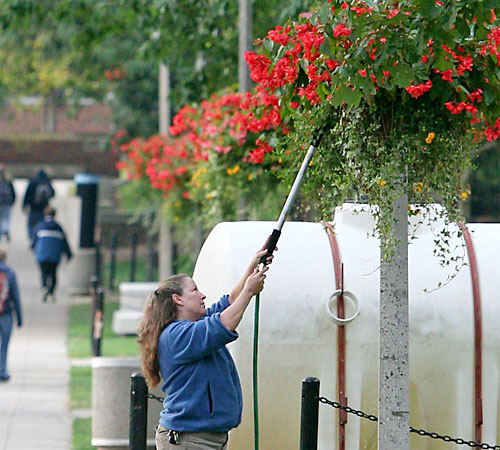Groups collaborate to maintain campus grounds

Linda Black, a University grounds worker, waters flowers along the Quad on Tuesday morning. Erica Magda
October 8, 2008
At 7 a.m. on a weekday, when some students are beginning to wake up for classes, an entire team of grounds workers is already on the job, working to maintain the appearance of 1,470 acres of campus land.
They pick up trash, empty trash bins, mow lawns, water flowers, fix small potholes and remove snow from sidewalks in the winter. This year, they are operating under a $2.2 million budget.
The grounds division of Facilities and Services maintains the majority of campus lands. Grounds officials organize their work by dividing the campus into four sections and letting each section’s supervisor assign tasks, said Ron Brown, grounds sub-foreman.
Seniority has some influence over who performs which tasks, but grounds workers usually end up doing everything from blowing leaves to picking up trash to putting down grass seed, said grounds worker Linda Black.
“I’ve worked all over campus in the time I’ve been here,” said Black, who has been a full-time grounds worker for three years, following 12 years of working part-time. “I’ve used all the equipment for mowing, maintenance, irrigation. Pretty much anything you see in this area, I’ve used.”
Get The Daily Illini in your inbox!
Black’s current assignment includes watering the hanging flower baskets and circular flower urns lining the paths on the Quad. She said she begins driving a water wagon around and watering the flowers each weekday at 7 a.m. and finishes by about 11 a.m.
While the grounds of the Quad and most classroom buildings are maintained by Facilities and Services’ grounds division, Brown said the Division of Intercollegiate Athletics and Campus Recreation have their own grounds maintenance staffs.
A staff of 21 athletic facility attendants for the Division of Intercollegiate Athletics maintains the University’s varsity playing fields as well as the grounds surrounding athletic administration buildings, said John Donahoe, superintendent of grounds for the division.
Donahoe said the staff works around athletic teams’ schedules and repairs the fields from overuse. Funding for grounds maintenance comes out of the their overall budget of $70.7 million, he said.
Campus Recreation maintains between 40 and 45 acres of playing fields including outdoor basketball and sand volleyball courts, and rugby, soccer and lacrosse fields with its own staff, said Tom Singer, play field maintenance supervisor.
“But the grounds around the Campus Recreation Center East, the ARC, the Outdoor Center and the Ice Arena are handled through Facilities and Services,” said Gary Miller, associate director of construction and member services. “We’re a little bit of a hybrid.”
Some of the Division of Intercollegiate Athletics’ grounds maintenance work also gets completed by the Facilities and Services grounds staff or by other outside contractors, Donahoe said.
Landscaping or grounds maintenance projects that cost more than $26,500 must be completed by an outside contractor, he said.
For projects under that amount, the Division of Intercollegiate Athletics can hire the Facilities and Services grounds crew or a company on the Facilities and Services prime and preferred supplier list, a compilation of vendors and contractors suggested for different types of jobs and purchases.
“The primary criteria is the lowest bidder, but they also have to have other qualifications,” Donahoe said. “Sometimes they have to have completed a certain number of a type of project to be considered.”
Brown said the Facilities and Services grounds division has been working to keep costs down by buying updated equipment with good fuel efficiency and by saving leaf clippings to use as fertilizer for lawns and flower beds.
“We’ve been working toward this for a long time, even before gas prices went up,” Brown said. “Now we’re looking at it a little harder.”
The division recently designated a few areas on campus “no-mow” zones.
The land surrounding Dorner pond near Allen Hall and McKinley Health Center is one example of a no-mow area designed to increase green space on campus as well as cut fuel costs, Brown said.
But maintaining all the lawns, playing fields and walking paths on campus takes more than just money.
Grounds maintenance jobs also require patience at times when students are around.
“Sometimes students get irritated by us,” Black said. “But the only way you guys are going to get around is if we get our job done.”






